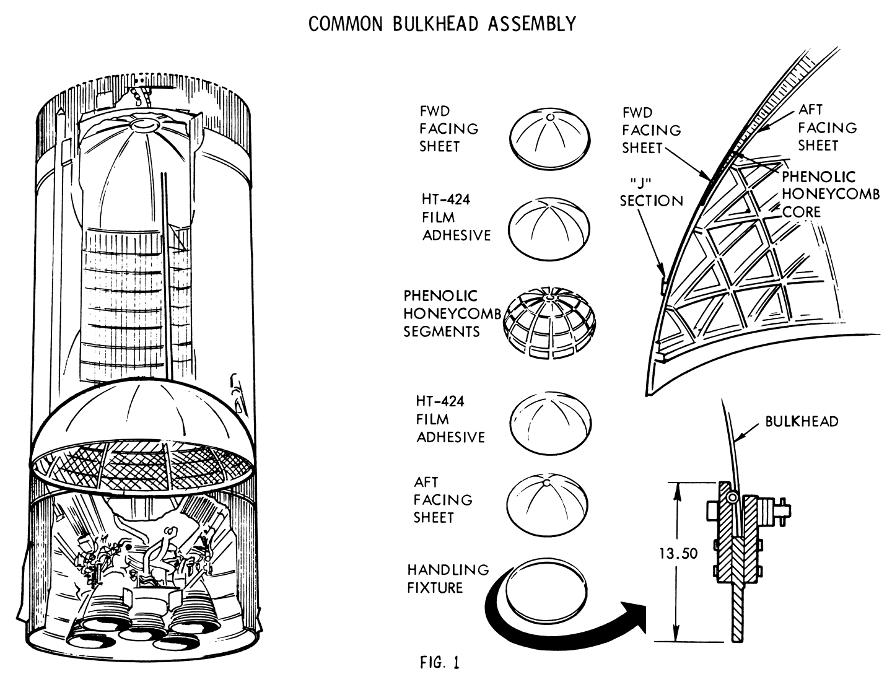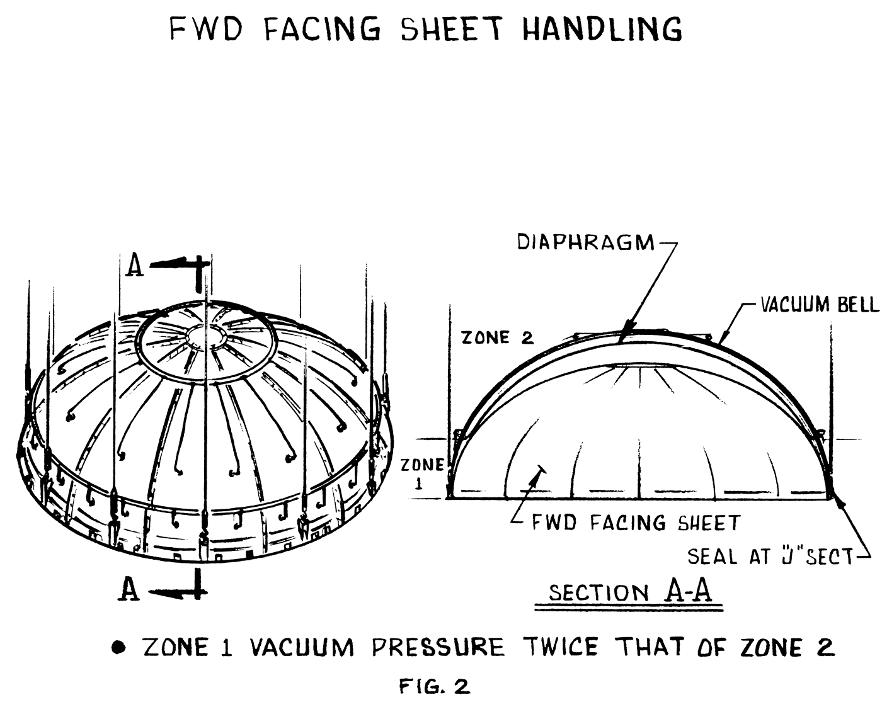The Common Bulkhead for
the Saturn S-II Vehicle
Unique Manufacturing Effort Adds to Space-Age Hardware Technology
Presented by:
C. Tony Cerquettini
Project Administrator
SATURN S-II Insulation and Plastics
When the APOLLO Rocket, the SATURN V, tall as a 30-story building and weighing as much as a nuclear submarine, rumbles into space on its journey to our neighbor the moon, scores of engineering marvels will bid for world attention. And not the least among these will be a thin sandwich of metal and phenolic honeycomb called the common bulkhead, in the second stage of the three stage rocket, the stage known as SATURN S-II.
The SATURN S-II built by North American's Space and Information Systems Division for NASA's Marshall Space Flight Center will contain a dome-shaped wall, or bulkhead, cleverly designed and made as a barrier between two supercold liquids - oxygen at 297 degrees below zero and liquid hydrogen at 423 degrees below zero.
It is the common bulkhead — common to both the hydrogen on one side and the oxygen on the other — which will hold the fuel and oxidizer apart.
Each of the two bulkheads are fabricated out of 2014 T6 aluminum alloy and are 33 feet in diameter and 12 feet high. After welding and hydrostat, the surface to be bonded is chemically cleaned and primed with HT 424 pre-bond primer.
The manufacture of a shape, essentially a half-sphere, to take the seven and one-half million pounds of thrust during the initial boost period of the moon rocket, and act as a thermal barrier between the supercold liquids, set up very critical requirements. The result was new types of tooling, programmed measuring of a huge surface, new welding, inspection and cleaning processes.
Click image for a 5786x4417 pixel version of this image in a new window.
Scan and reconstruction by heroicrelics.org.
A unique method of manufacture — inflating the big, and flexible dome-shaped sides of the bulkhead to hold them in shape during the critical time of fitting the honeycomb core was used. Inflating removes the flat spots much as the flat spots of a toy balloon are removed by inflating. With the skins sealed to the floor in jigs and inflated at low pressure, the honeycomb material of the "sandwich" could be fitted to the shape of the master dimensions within the required 10,000ths of an inch.
From flat stock, each side of the bulkhead is made up by the manufacture of twelve curved aluminum pie shaped sections, called "gores" to form the dome shape, which contains a compound contour, including three curves — toroidal, elliptical and conical. These gore sections are chemically milled to taper from a half inch thickness at the wide base section to approximately 1/32 of an inch. To close off the top of the resultant dome shape, a round and cupped metal "cork" is welded in at the apex. This section, known as a "dollar," is three feet in diameter. These great domes, due to their thin sections, have relatively little strength by themselves. This is where the inflation and vacuum techniques are used — to hold the true shape during the manufacturing cycle.
The honeycomb sandwich material rises to a thickness of nearly five inches at the apex to about 1/8 of an inch from the bottom where such thickness is not necessary. The Glas-fabric core is furnished by Honeycomb Products.
To accomplish the fitup of the honeycomb core to the aft common bulkhead for final assembly bonding, the inflation technique is employed. Briefly, this technique is to inflate, at low pressures, the forward and aft bulkhead skin assemblies into smoothly faired contours. Both faces of the honeycomb core are then fitted from recorded dimensional traces of the actual pressurized skin contours. This controls the core thickness and profile concentricity by calculations derived from the contour traces. The skins are then bonded to the core in a condition of preload induced by applications of vacuum and/or pressure.
Click image for a 5689x4511 pixel version of this image in a new window.
Scan and reconstruction by heroicrelics.org.
This bulkhead manufacturing technique reduces manufacturing costs by eliminating the need for hard tooling, in full or semi-contact with the skins. It reduces or eliminates contour discrepancies resulting from material canning and provides a smoothly faired bulkhead.
The inflation technique is a major advance in missile fabrication, successfully challenging problems posed by immense size, weight, precision and strength requirements to help SATURN S-II achieve its critical mission — to boost its human cargo safely from 5000 to 15,000 miles per hour, from 38 to 113 miles out of the Earth's gravitational field and on the way to the moon.
Additional detailed information is available by contacting:
C. Tony Cerquettini
12214 Lakewood Boulevard
Department 560, Mail Code KB70
Downey, California
Download Links
The original document which I scanned, located in the Saturn V Collection, Dept. of Archives/Special Collections, M. Louis Salmon Library, University of Alabama in Huntsville, was badly faded. Heavy post-processing produced only barely acceptable results for the pages with text. The pages with graphics, however, scanned reasonably well.
I've prepared two PDFs:
- A web-resolution PDF for the casual visitor; 1.1 megabytes. View now. Note that there appears to be a bug in Acrobat X Pro's downsampling code which causes it to randomly rotate some pages during the OCR process; thus, page 3's graphic is incorrectly skewed.
- A version with 600 dpi graphics for serious study; 3.8 megabytes. Download now.


